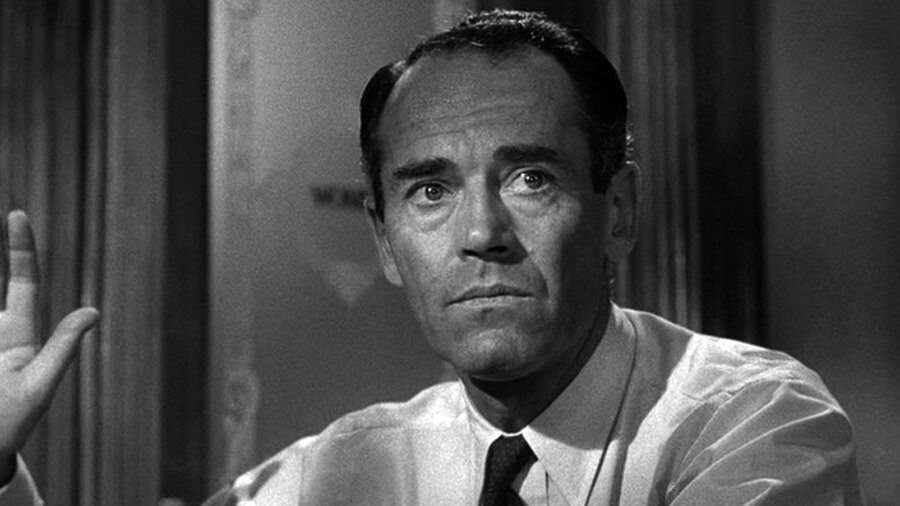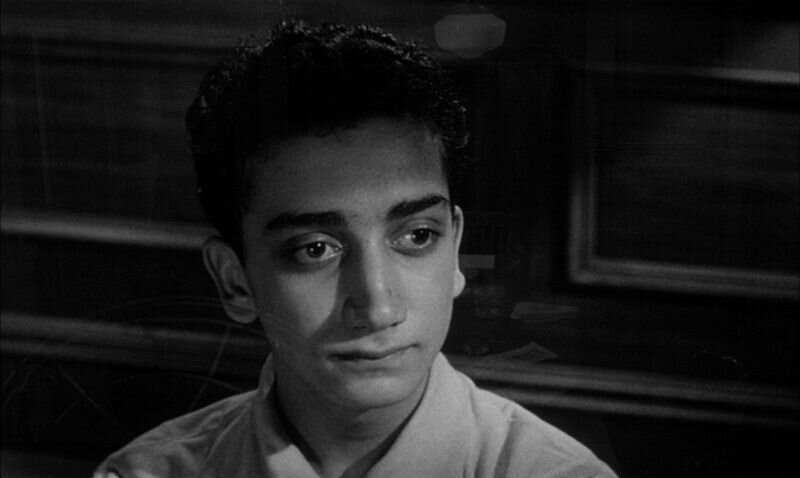12 Angry Men – 1957 Sidney Lumet
Angry, yes I suppose. And also very sweaty.
It’s amazing that this whole film is just one room and so engaging. Shooting dialogue for 90 minutes, and varying angle and light and distance for tone all worked so well.
It’s incredibly well shot actually. I thought at first that the close ups on the dissenter (Juror 8) were a lot like romantic portrait lighting, with a soft irised-down keylight and that this was supposed to be meaningful, for only him. But other characters each later get this treatment as well. That’s just how they liked to light the close ups I guess.
I was expecting, in part from this light, that there would be a turn where it was revealed he had some malicious intention, like a Keyser Söze moment. Or maybe he were somehow friends with the accused or from the same slum or was somehow otherwise meddling with the trial. I was suspicious for a good portion of this film. There is also an early shot after he reveals he has doubts, in which there is a strange turn in the music from happy and chirpy to a sinister final few bars as we dolly in on him. I thought they were showing their cards here.
'I know their type, he’s one of them’
I thought the point of the story might be to show how easily people can be swayed for good or ill, persuaded by someone’s slick talking. Especially in our current age of subjective truth and a misinformed public and the propaganda machine which is Fox News and AM Radio that is constantly working to undermine the idea of truth.
But the story is rather about first how people can be persuaded sure (maybe I was half right), but also how even when things seem clear cut, with deeper examination they may not be. And that our personal internal prejudices do more to affect our opinions than we realize. Lumet himself explains it that the dissenter is the hero, he is the voice of reason. This I missed until much later when it becomes obvious that the hard guilty plea people have deeper prejudices.
The story is also about race and class prejudice which makes sense for the time it were made. The assumptions you make of your neighbors who are different ‘those people’ ... ‘they don’t value human life like we do’. And sadly, these prejudices still haunt us, even if their forms may have altered slightly. We are still dealing with these misconceptions of our neighbors in America, right now.
Another very interesting technical detail on display here is the staging and camera morphing across the whole picture. That as the characters and story have arcs they follow, so too does the camera. In his book, Making Movies, Lumet describes this at play in several pictures. Using aesthetic elements to convey meaning over the course of the film.
THE LENS PLOT – From Making Movies - Chapter Five, The Camera
It never occurred to me the shooting an entire picture in one room would be a problem. In fact I felt I could turn it into an advantage. One of the most important dramatic elements for me was the sense of entrapment those men must have felt in that room. Immediately a 'lens-plot' occurred to me. As the picture unfolded, I wanted the room to seem smaller and smaller. That meant that I would slowly shift to longer lenses as the picture continued. Starting with a normal range (28mm-40mm) we progressed to 50mm, 75mm and 100mm lenses.
In addition, I shot the first third of the movie above eye level. And then, by lowering the camera, shot the second third at eye level and the last third below eye level. In that way, by the end, the ceiling began to appear. Not only were the walls closing in, the ceiling was as well. The sense of increasing claustrophobia did a lot to raise the tension of the last part of the movie.
On the final shot, an exterior that showed the jurors leaving the courtroom, I used a wide angle lens. Wider than any that had been used in the entire picture. I also raised the camera to the highest above eye-level-position. The intention was to literally give us all air, to let us finally breathe, after two increasingly confined hours.
This is a very simple idea to execute across the film and it’s affect might be hard to detect viewing casually. But surely you can feel it. This decision adds to the overall feeling in the film in ways that the acting should, the light should… but here the camera too is used to make you feel the story. It’s so smart.
His book is one of the best I’ve ever read on the technical and creative process of making a film and the decisions that go into directing. I strongly recommend it anyone interested in movies.



